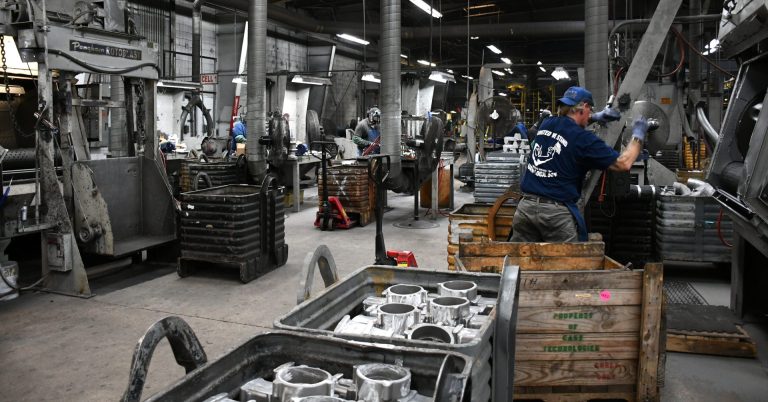The Leading Methods for Light Weight Aluminum Spreading That You Required to Know
From the typical sand spreading method to the complex financial investment casting procedure, each technique uses distinct benefits that cater to various task demands. As we browse with the top strategies for light weight aluminum casting, it becomes evident that mastering these techniques is essential for achieving ideal results.
Sand Spreading Technique
The Sand Spreading Strategy is a basic method in light weight aluminum spreading, widely utilized for its cost-effectiveness and adaptability in producing detailed steel forms. This strategy includes developing a mold and mildew constructed from compressed sand right into which molten light weight aluminum is put, allowing it to take the shape and solidify of the mold and mildew. One of the essential advantages of sand casting is its capability to produce intricate geometries with reasonably reduced tooling costs, making it an eye-catching alternative for manufacturers seeking to create one-of-a-kind elements.
In the sand spreading process, a pattern of the final part is pushed into a fine sand blend contained within a flask. Sand casting is commonly utilized in various markets, consisting of auto, aerospace, and art factories, due to its ability to produce both big and little steel elements with intricate designs.

Investment Casting Process
An elaborate approach used in light weight aluminum casting is the Financial investment Casting Refine, known for its capacity to generate very detailed and intricate steel components. Referred to as the lost-wax spreading process, this technique dates back thousands of years and remains a preferred option in numerous sectors due to its versatility and precision.
The financial investment spreading process begins with the development of a wax pattern, which is coated with a ceramic covering to form a mold. The wax is then thawed out, leaving a tooth cavity in the form of the preferred component. Molten aluminum is poured right into the ceramic mold, taking and filling the cavity on the detailed information of the original wax pattern.
This approach is preferred for its ability to generate complicated shapes with outstanding surface coating and dimensional precision. It is typically used in the manufacturing of aerospace components, fashion jewelry, and commercial equipment where detailed layouts are required. The financial investment casting process uses high repeatability and can produce components with marginal machining needed, making it a cost-efficient selection for lots of applications.
Permanent Mold Technique
Using a various strategy from the Investment Casting Refine, the Permanent Mold and mildew Method in aluminum spreading supplies a distinctive technique for creating metal elements. The warmth transfer from the liquified steel to the mold helps in strengthening the aluminum quickly, reducing the cooling time compared to sand spreading.
Among the essential advantages of the Irreversible Mold Approach is the enhanced surface area finish and dimensional precision of the castings created. This method is also known for its ability to generate high-strength light weight aluminum components with regular top quality. In addition, the multiple-use nature of the mold makes it an affordable option for tool to high quantity production runs.
Pass Away Casting Innovation
Making use of sophisticated manufacturing procedures, die casting modern technology offers a highly effective approach for producing complex light weight aluminum components. This technique includes injecting molten aluminum right into a steel mold and mildew, known as a die, at high pressures. The die is specifically made to form the aluminum into the wanted kind, resulting in high precision and outstanding surface coating.
Pass away casting deals numerous benefits. It allows for the production of complex shapes with thin walls, tight tolerances, and smooth surfaces, making it suitable for applications where aesthetic appeals and accuracy are important source essential. Additionally, die casting allows fast production prices, minimizing total production time and prices.

Lost Foam Spreading Approach
Pass away casting modern technology's performance and accuracy in generating light weight aluminum parts lead the means for discovering the Lost Foam Spreading Technique as a corresponding manufacturing method. Lost Foam Casting, likewise understood as evaporative pattern casting, is a method that uses foam patterns to develop detailed light weight aluminum components.
One of the crucial advantages of Lost Foam Spreading is its ability to generate complicated layouts with complex details that view it might be challenging to attain with conventional spreading methods. As sectors continue to require lightweight yet sturdy components, Lost Foam Casting proves to be a beneficial method in the world of aluminum spreading.
Conclusion
In verdict, comprehending the leading techniques for light weight aluminum spreading is vital for achieving top notch cause the production process. Sand casting, financial investment spreading, long-term mold and mildew, pass away casting, and lost foam spreading are all effective techniques for generating light weight aluminum get rid of different degrees of intricacy. By mastering these methods, suppliers can ensure that their products satisfy the wanted specifications and requirements for efficiency and durability.
From the conventional sand spreading technique to the complex investment casting process, each method supplies unique advantages that cater to different job demands.The Sand Spreading Strategy is a fundamental method in aluminum casting, commonly used for its cost-effectiveness and adaptability in developing detailed steel forms. Lost Foam Spreading, additionally recognized linked here as evaporative pattern spreading, is an approach that makes use of foam patterns to develop detailed light weight aluminum components. As sectors proceed to demand light-weight yet sturdy parts, Lost Foam Casting confirms to be a valuable approach in the world of light weight aluminum spreading.
Sand casting, financial investment spreading, irreversible mold and mildew, pass away casting, and lost foam casting are all efficient approaches for generating light weight aluminum components with various degrees of complexity.